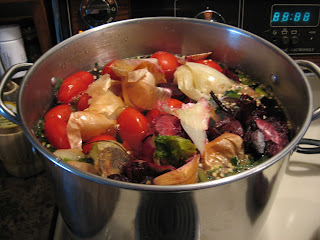Homemade Naan Bread
recipe from Madhur Jaffrey's cookbook, World Vegetarian
5 cups white flour (you could probably use any flour, but I have only used white)
1 1/2 tsp. baking powder
1 tsp. baking soda
1/2 tsp. salt
1 1/2 tsp. sugar
2 tbsp. plain yogurt (I used about 3)
1 cup milk
1 cup water
1 egg
1 tbsp. melted butter, plus more for cooking with
1/2 tsp. nigella and 1 tsp. sesame seeds (I did not use these)
Sift together flour, baking powder, baking soda, and salt. In a large mixing bowl, mix together sugar and yogurt with an electric mixer. Add the milk and water to yogurt and mix well. Slowly begin adding 2 cups of the flour mixture, little bits at a time. When all of the flour is incorporated, mix well for 2-3 minutes on medium speed to build up the gluten in the flour. Add the melted butter and the egg and mix well. Now slowly begin adding the rest of the flour, switching to a wooden spoon when the mixture becomes too thick for the electric mixer. The dough should be very soft and sticky. Dump it out onto a floured surface and knead a few times with oiled hands. Divide the dough into 8-12 balls, depending on the size of your cast iron pan (I did 12 for my medium sized cast iron pan). Liberally dust a baking tray with flour and place the balls two inches apart. Press and flatten the balls slightly with your floured hand and cover them with a tea towel (please do not use plastic wrap, a towel works just as well). Refrigerate the naan for at least 30 minutes or up to 48 hours.
When you are ready to cook them, preheat your pan for 5 minutes. Melt a few more tablespoons of butter and dip your fingers in it. Take one naan at a time and press and shape them into a tear drop shape about 6 or 7 inches long (or long enough that the dough is about 1/2 inch thick and it will fit nicely onto your pan). Brush the top with a bit more butter and place (buttered side down) onto the hot pan. Sprinkle a small amount of seeds onto the top of the dough (if you are using them). Cook for about 2 minutes, or until nicely browned. Now because I don't use the seeds, I simply butter the top and then flip my naan over and cook them for another 2 minutes on the other side. However, the seeds would probably all fly off if you did that, so You can finish it off under the broiler until nicely blistered and brown. Cook all of the naan this way and keep them warm in the oven until you are ready to eat them.
I would recommend only cooking enough to eat with your meal and leaving the rest in the fridge so you can make fresh ones as you want them over the next 2 days. Fresh off the pan is really the best way to have them. Or you could just cook them all and then eat a ridiculous amount of buttery, hot naan and feel really indulged and satisfied. I fully support that method :).
I don't have a picture of the finished product, but this is what they should look like:
Tonight we are having this delicious bread with chana masala, recipe found here, and bengali spiced squash, also in World Vegetarian.
What have you been cooking lately?






















